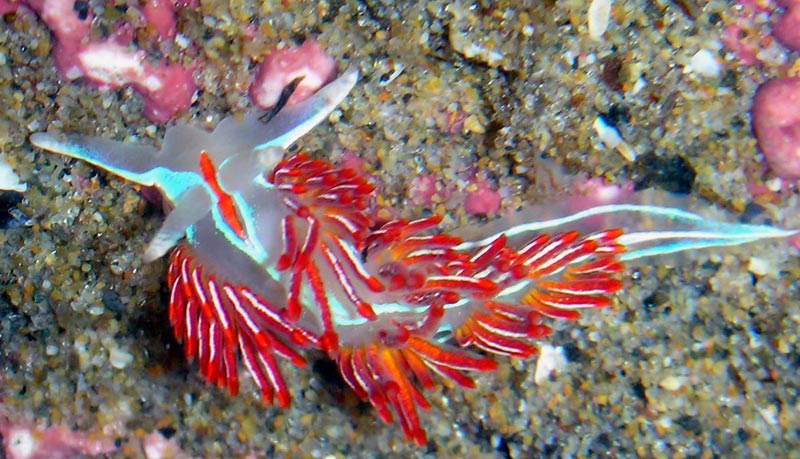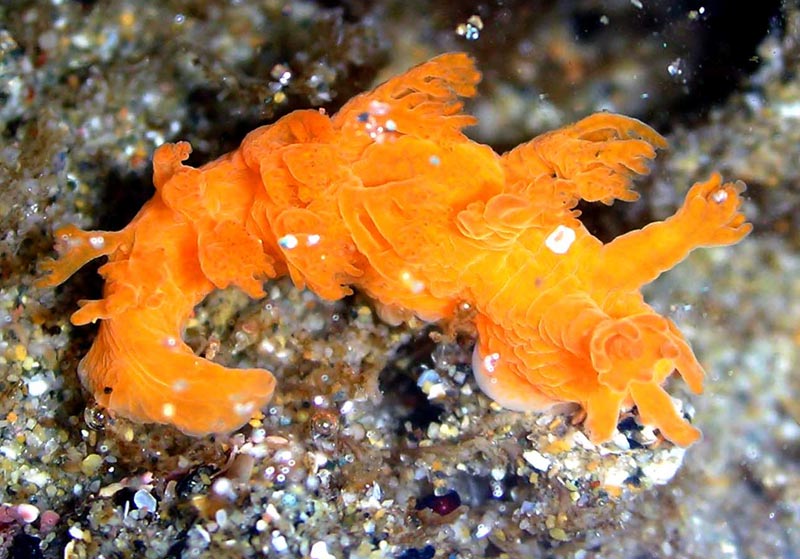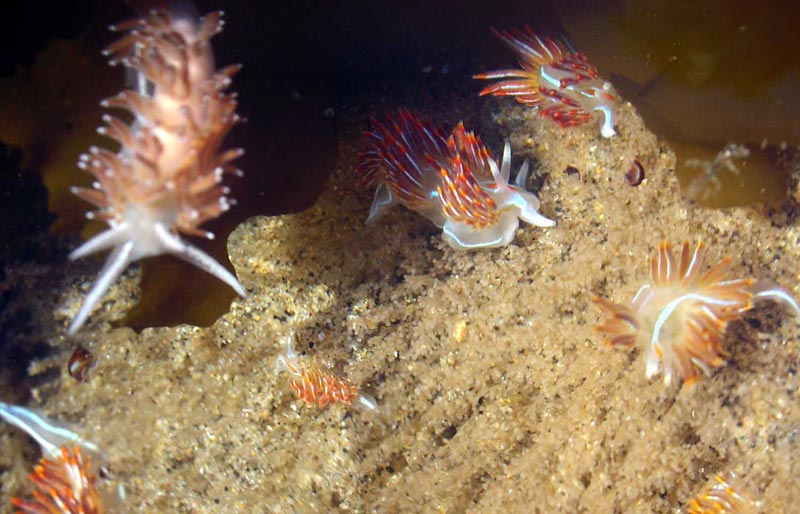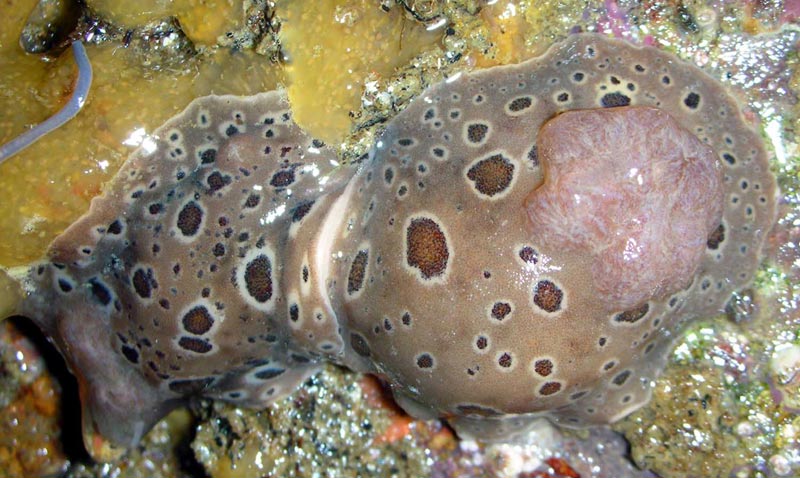The Striking, Brightly-Colored Nudibranchs of Oregon / Washington Coast Tidepools
Published 01/22/21 at 5:56 aM PDT
By Oregon Coast Beach Connection staff

(Oregon Coast) – From the bottom of sea stacks at Bandon or Myers Beach on the southern Oregon coast, to the vast colonies of Bob Creek near Yachats, at Cannon Beach or up on the Washington coast, tidepools are entire other worlds of stunning beauty lying around in this world. They're little ecosytems all their own: full of color, all manner of things poky and gooey, and utterly alien. (All photos courtesy Tiffany Boothe / Seaside Aquarium. Above: opalescent nudibranch / Hermissenda opalescens)
But are you seeing everything?
Includes exclusive listings; some specials in winter
In Cannon Beach:
Includes rentals not listed anywhere else
In Manzanita, Wheeler, Rockaway Beach:
Some specials for winter
In Pacific City, Oceanside:
Some specials for winter
In Lincoln City:
Some specials for winter
In Depoe Bay, Gleneden Beach:
Some specials for winter
In Newport:
Look for some specials
In Waldport
Some specials for winter
In Yachats, Florence
Some specials for winter
Southern Oregon Coast Hotels / Lodgings
Reedsport to Brookings, places to stay; winter deals
As colorful as they are, one set of tidepool species sort of hides in plain sight. What are usually just cursory glances at these little environments left off by the tides doesn't tell you everything. One wild little beastie wears not only a myriad of bright, striking shades but incredible and different forms as well.
They're called nudibranchs (the ch is pronounced with a k sound), sometimes known as sea slugs. Some 3,000 different species inhabit the world's oceans and tidepools, ranging in length from 1/8 inch to 12 inches. Around the Pacific Northwest beaches of Oregon and Washington's coastline, there's about 200 different varieties. Some work to hide themselves, others blatantly show off in effort to keep themselves noticed.

There's such a variety of them it's impossible to display all.
Near the border of both the Washington and Oregon coast, Tiffany Boothe of Seaside Aquarium works with them a lot.
“Nudibranchs are marine snails, relatives of limpets and abalone,” Boothe said. “Through evolution they have lost their shell. In fact, the name nudibranch means ‘naked gills,' referring to the fact that their gills are on the outside of the body. While most lack shells some species have a reduced or internal shell.”
Like many other creatures on land and in the sea, if a nudibranch has a bright coloration it's a warning: chomp here and you'll get a mouthful o' nasty and maybe even poison. Scientists often observe fish swallow them and then spit them back out. It takes some time, but many fish learn not to lunch on “that thing” again.

Being a snail they move quite slowly on the bottom of the ocean. Some of these funky creatures have numerous body projections which are called cerata, which increases the overall body surface as well as enhances breathing.
Most if not all species of nudibranchs live in small, special environments particularly suited to them. They often have a narrow range of diet as well as other physological limitations or needs. Boothe said that many aquariums can't house them because of the highly specialized environments needed.
Do they sting? Yes, they do, depending on the species. Boothe said this feels like a bee sting – not too bad. When she handles them it's rare that she's been stung, but it's happened.
That stinging capability takes on a weird twist with the nudibranch.
“Nudibranchs often feed on prey that most sea creatures deem unpalatable, such as hydroids and sea sponges,” Boothe said. “Some nudibranchs, such as the Opalescent (Hermissenda crassicornis), can recycle the stinging cells (called a nematocyst) of its prey to use in its own defense. The cells are often more concentrated in the nudibranchs, and after handling an Opalescent I am often left with a small itchy rash where the nudibranch stung me.”
One major rule – even state law – is do not remove anything from a tidepool. If you're thinking of nabbing one of these vividly-tinged beasties, there's yet another defense. They'll suddenly lose their color or even form if taken out, which comes from their intensely narrow environmental needs. You'll have no show-and-tell if you do.
Boothe said they're more visible during warmer times of the year, but nudibranchs are indeed always around no matter the season. MORE PHOTOS BELOW
Oregon Coast Hotels for this event - Where to eat - Map - Virtual Tour
Cannon Beach Lodging
Nehalem Bay Lodgings
Manzanita Hotels, Lodging
Three Capes Lodging
Pacific City Hotels, Lodging
Lincoln City Lodging
Depoe Bay Lodging
Newport Lodging
Waldport Lodging
Yachats Lodging
Oregon Coast Vacation Rentals
Oregon Coast Lodging Specials


More About Oregon Coast hotels, lodging.....
More About Oregon Coast Restaurants, Dining.....
LATEST Related Oregon Coast Articles
Through 2 a.m. likely best, but some lights possible through dawn June 1 - 2. Space weather, astronomy
Rare Sperm Whale Stranding on N. Oregon Coast, Was Hit by Boat
Showing up near Gearhart, it will decompose naturally. Marine sciences
Coast Guard Barque 'America's Tall Ship' Coming to Portland Rose Fest, N. Ore...
Portland events: June 5 - 8; Astoria events June 13 - 15. Weather
Bright and Active Arietids Meteors May Hit Pre-Dawn Hours of Oregon, Washingt...
Look to east hour before sunrise and you may catch a show. Sciences, astronomy, weather
Why Now Could Be a Great Week for Spotting Killer Whales on Oregon Coast - Video
A good dozen documentations around Depoe Bay, Newport, Coos Bay, Bandon, Tillamook. Marine sciences
Summer Road Work, Traffic Issues Along Oregon Coast Include Astoria, Garibald...
Some daylight closures include bridges, OR 22, OR 18, OR 26, more. Travel tips. Seaside, Cannon Beach, Lincoln City. Travel tips
Pacific City Oregon Weather, 7-Day Forecasts, Live Conditions, Radar, Webcams...
Updated Constantly: Pacific City, Tierra Del Mar, Oregon Weather, Cams, Buoy Observations, Tides, Warnings - Alerts
Oregon Coast Has World's Oldest Harbor Seal, Celebrating 50 Years Soon
June 3 at Oregon Coast Aquarium in Newport. Newport events
Back to Oregon Coast
Contact Advertise on BeachConnection.net
All Content, unless otherwise attributed, copyright BeachConnection.net Unauthorized use or publication is not permitted



















































